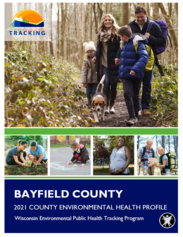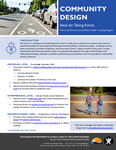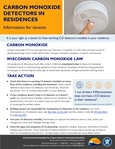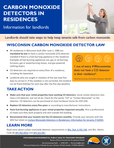
|
|
Environmental Public Health Tracking Newsletter
|


2021 County Environmental Health Profiles Released!
The Wisconsin Environmental Public Health Tracking Program is excited to announce the release of the 2021 County Environmental Health Profiles!
These profiles provide a county-level snapshot of the data available on the Tracking data portal. Through these profiles, communities can learn more about environmental health-related topics such as lead poisoning, water quality, and Lyme disease. Readers can explore the data and create charts, maps, and tables on our data portal.
We also have some new data for 2021! The profiles now include data on motor vehicle-related fatalities, chronic obstructive pulmonary disease (COPD), and extreme heat and precipitation projections.
We’ve put together resources to help you take the next step:
-
Messaging Tips and Sample Press Release: If you plan to write a press release to share highlights from your profile, our messaging tips and a sample press release can help you get started. These files are housed in Sharepoint. If you cannot access Sharepoint, please email us and we'll send you the files.
-
Ideas for Taking Action: Review Ideas for Taking Action, a series of documents that outline potential strategies—from the individual to policy level—a community can take to address the topics in the profiles.
We want to hear what you think of the 2021 Profiles!
Please complete this short survey letting us know how you use the profiles and what you would like to see in future versions. Your feedback will help us create profiles that are most useful to you!
If you have questions about the County Environmental Health Profiles or the Tracking Program, please do not hesitate to contact us.
|

New Mini-Grantees Off to a Great Start!
On August 1, our newest cohort of grantees kicked off their projects under our Taking Action with Data mini-grant program. Six grantees were funded at up to $10,000 each to complete small-scale environmental health projects in their communities over the next year. Their project proposals were based on local data from our data portal.
This year's grantees include:
Bayfield County—Cooling and Warming Shelter Outreach
Brown County—Increasing Childhood Lead Testing Rates through Provider Medical Records
Calumet County—Lowdown on Lyme Disease
City of Oak Creek—Taking Action to Educate on the Risks of Radon: To Test is to Know
Green Lake County—Carbon Monoxide Poisoning Prevention in High Risk, Rural Populations
Lincoln County—Increasing Manganese Water Testing in Lincoln County
This is the sixth year of the Taking Action with Data mini-grant program. Since 2015, we have invested $430,000 to fund 44 projects in 32 Wisconsin jurisdictions. To read success stories from these projects, visit our Resources page.
|

CDC Tracking Has Released a New Melanoma Dashboard!
This dashboard was created through a partnership between the CDC's Division of Cancer Prevention and Control and CDC’s Environmental Public Health Tracking Program and provides a wide range of state and local data to help communities address melanoma prevention.
Key features include:
- State- and county-level data on melanoma incidence and mortality.
- State- and county-level data on UV irradiance.
- State policies regarding minors’ access to indoor tanning devices and sunscreen use at schools.
- Additional county-level data to help inform and target local prevention efforts.
Although melanoma incidence rates have continued to increase in recent years, evidence-based prevention strategies are available and ready to be put into action in communities. The Melanoma Dashboard provides easy access to the most recent and relevant data, empowering users to communicate effectively about the burden of melanoma and make data-driven decisions that will maximize the impact of their prevention efforts.
|
Your Tracking Toolbox!
In each newsletter we share new environmental health resources to help you share Tracking data with various audiences. We have three new fact sheets highlighting the data topics of community design and carbon monoxide.
|
Community Design Ideas for Taking Action
Our health is influenced by the design of our communities. Designing communities that encourage healthy choices is critical to improving the health and quality of life of community members. Check out our new fact sheet, Community Design: Ideas for Taking Action, that includes potential strategies for improving health through community design.
|
|
 |
 |
|
Carbon Monoxide (CO) Detectors in Residences: Information for Tenants
This one-page fact sheet outlines the basics of carbon monoxide poisoning, the Wisconsin carbon monoxide law, and what actions tenants can take to prevent CO poisoning.
|
|
Carbon Monoxide (CO) Detectors in Residences: Information for Landlords
This one-page fact sheet outlines the basics of carbon monoxide poisoning, the Wisconsin carbon monoxide law, and what actions landlords can take to help protect their tenants from CO poisoning.
|
|
 |
|
|
Please do not reply to this email message. If you have a question, please email the Tracking Team. Additional information about Environmental Public Health Tracking is available on the Department of Health Service website.
|
|
|